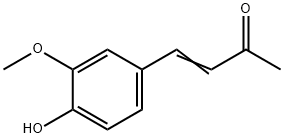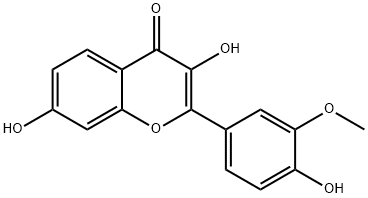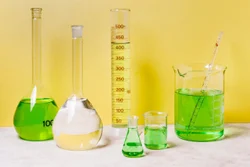Vanillylidenacetone
Synonym(s):4-(4-Hydroxy-3-methoxyphenyl)-3-buten-2-one
- CAS NO.:1080-12-2
- Empirical Formula: C11H12O3
- Molecular Weight: 192.21
- MDL number: MFCD00012210
- EINECS: 214-096-9
- SAFETY DATA SHEET (SDS)
- Update Date: 2025-12-11 08:41:34

What is Vanillylidenacetone?
Description
Dehydrozingerone (1080-12-2) is a structural half analog of curcumin (Cat.# 10-1243) and is isolated from ginger rhizomes. Dehydrozingerone displays antioxidant, antibacterial and antifungal properties.1 It has also been shown to possess various antitumor effects2,3 and inhibit growth factor/peroxide-stimulated vascular smooth muscle function4.
Chemical properties
Vanillylidene acetone has a very sweet, warm and tenacious odor.
Physical properties
Yellowish, needlelike crystals. Slightly soluble in water, soluble in alcohol and oils.
The Uses of Vanillylidenacetone
Vanillylidenacetone is one of ferulic acid derivatives. Studies have shown that vanillyl acetone has a certain inhibitory effect on Amaranthus, barnyardgrass, matang, dogwood and rape, among which the best inhibitory effect is on rape and Amaranthus.
What are the applications of Application
Vanillylidenacetone is n intermediate shown to inhibit cell growth
Definition
ChEBI: Dehydrozingerone is a hydroxycinnamic acid.
Taste threshold values
Taste characteristics at 200 ppm: balsamic vanilla, with sweet aromatic spicy nuances.
References
1) Kubra et al. (2014), Structure-function activity of dehydrozingerone and its derivatives as antioxidant and antimicrobial compounds; J. Food Sci. Technol., 51 245 2) Motohashi et al. (1998), Inhibitory effects of dehydrozingerone and related compounds on 12-O-tetradecanoylphorbol-13-acetate induced Epstein-Barr virus early antigen activation; Cancer Lett., 134 37 3) Yogosawa et al. (2012), Dehydrozingerone, a structural analog of curcumin, induces cell-cycle arrest at the G2/M phase and accumulates intracellular ROS in HT-29 human colon cancer cells; J. Nat. Prod., 75 2088 4) Liu et al. (2008), Inhibitory effect of dehydrozingerone on vascular smooth muscle cell function; J. Cardiovasc. Pharmacol., 52 422
Properties of Vanillylidenacetone
| Melting point: | 125-130 °C |
| Boiling point: | 268.19°C (rough estimate) |
| Density | 1.1503 (rough estimate) |
| refractive index | 1.4600 (estimate) |
| FEMA | 3738 | VANILLYLIDENE ACETONE |
| storage temp. | under inert gas (nitrogen or Argon) at 2-8°C |
| solubility | Soluble in DMSO (up to 25 mg/ml) or in Ethanol (up to 20 mg/ml). |
| form | solid |
| pka | 9.94±0.31(Predicted) |
| color | Pale yellow |
| Odor | at 100.00 %. sweet powdery vanilla creamy balsam |
| JECFA Number | 732 |
| Stability: | Stable for 1 year from date of purchase as supplied. Solutions in DMSO or ethanol may be stored at -20° for up to 1 month. |
| CAS DataBase Reference | 1080-12-2(CAS DataBase Reference) |
| EPA Substance Registry System | 3-Buten-2-one, 4-(4-hydroxy-3-methoxyphenyl)- (1080-12-2) |
Safety information for Vanillylidenacetone
| Signal word | Warning |
| Pictogram(s) |
 Exclamation Mark Irritant GHS07 |
| GHS Hazard Statements |
H302:Acute toxicity,oral H315:Skin corrosion/irritation H319:Serious eye damage/eye irritation H335:Specific target organ toxicity, single exposure;Respiratory tract irritation |
| Precautionary Statement Codes |
P261:Avoid breathing dust/fume/gas/mist/vapours/spray. P305+P351+P338:IF IN EYES: Rinse cautiously with water for several minutes. Remove contact lenses, if present and easy to do. Continuerinsing. |
Computed Descriptors for Vanillylidenacetone
New Products
Indole Methyl Resin tert-butyl 9-methoxy-3-azaspiro[5.5]undecane-3-carboxylate Boc-His(Boc)-OH 2-CTC Resin 4-Chloro-7-tosy1-7Hpyrrolo[2,3-d]pyrimidine 5,7-Dibromo-1H-indole 2,5-dichloro-N-hydroxy-4,6-dimethylpyridine-3-carboximidamide 2,2-Dimethoxy-7-azaspiro[3.5]nonane hydrochloride 4-chloromethyl-5-methyl-1,3-dioxol-2-one (DMDO-Cl) R-2-BENZYLOXY PROPIONIC ACID 1,1’-CARBONYLDIIMIDAZOLE 1,1’-CARBONYLDI (1,2-4 TRIAZOLE) N-METHYL INDAZOLE-3-CARBOXYLIC ACID 4-((2-hydroxyethyl)thio)benzoic acid 1-(TERT-BUTOXYCARBONYL)-2-PYRROLIDINONE Methyl 6-methylnicotinate 3-Pyridineacrylic acid tert-Butyl carbazate TETRAHYDRO-2H-PYRAN-3-OL 2-((4-morpholinophenylamino) (methylthio) methylene) malononitrile 3-(4-morpholinophenylamino)-5-amino-1H-pyrazole-4-carbonitrile 2,4-dihydroxybenzaldehyde 1,3-Diethyl-1,3-Diphenylurea Methyl 2-methylquinoline-6-carboxylateRelated products of tetrahydrofuran








You may like
-
 Crystals Yellow Crystal Vanillylideneacetone1080-12-2 VanillylideneacetoneView Details
Crystals Yellow Crystal Vanillylideneacetone1080-12-2 VanillylideneacetoneView Details
1080-12-2 -
 Pyridine 99.5% HPLC /UV SpectroscopyView Details
Pyridine 99.5% HPLC /UV SpectroscopyView Details
110-86-1 -
 Guanine , 99%View Details
Guanine , 99%View Details
73-40-5 -
 Piperazine Spot supply, best priceView Details
Piperazine Spot supply, best priceView Details
110-85-0 -
 Dibutyl PhthalateView Details
Dibutyl PhthalateView Details
84-74-2 -
 Imidazole Spot supply, competitive priceView Details
Imidazole Spot supply, competitive priceView Details
288-32-4 -
 Octadecyl 3-(3,5-di-tert-butyl-4-hydroxyphenyl)propionate 98% (GC)View Details
Octadecyl 3-(3,5-di-tert-butyl-4-hydroxyphenyl)propionate 98% (GC)View Details
2082-79-3 -
 Thiourea 99% ARView Details
Thiourea 99% ARView Details
62-56-6
